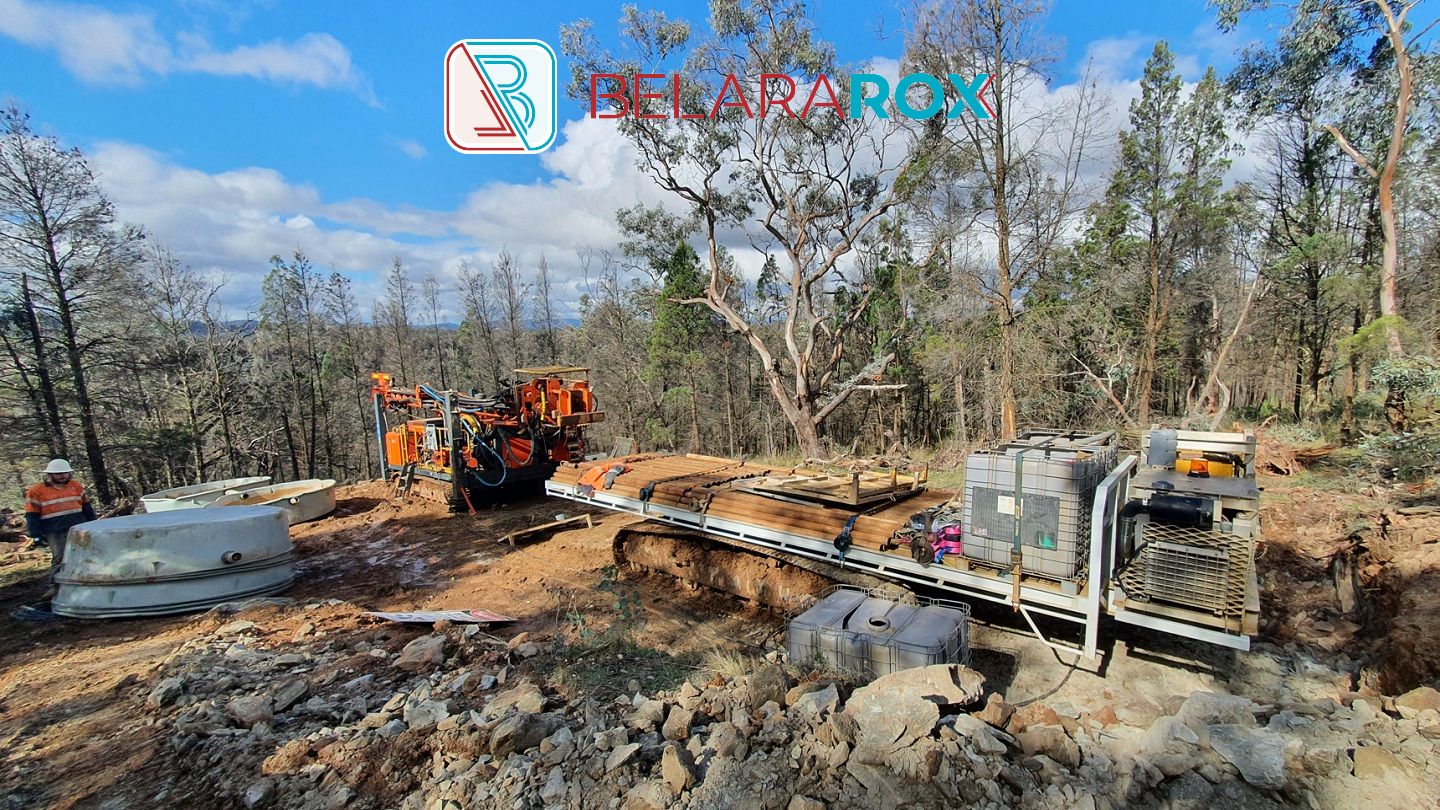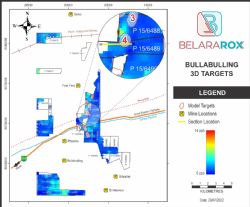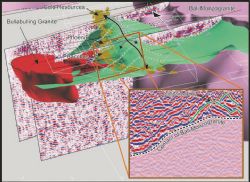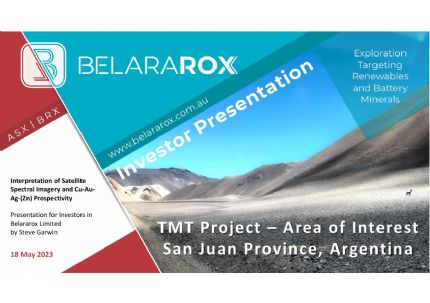 Drill Targets Defined at Bullabulling
Drill Targets Defined at Bullabulling
Perth, July 21, 2022 AEST (ABN Newswire) - Belararox Limited ( ASX:BRX), an advanced mineral explorer focused on high value clean energy metals, is pleased to announce that 3D prospectivity modelling has identified seven new exploration targets at the Bullabulling Project (Bullabulling) in WA. The modelling has mapped targets with the same geological features as the historic 3Moz Bullabulling and 320Koz Geko gold mines that have not been tested by exploration drilling.
ASX:BRX), an advanced mineral explorer focused on high value clean energy metals, is pleased to announce that 3D prospectivity modelling has identified seven new exploration targets at the Bullabulling Project (Bullabulling) in WA. The modelling has mapped targets with the same geological features as the historic 3Moz Bullabulling and 320Koz Geko gold mines that have not been tested by exploration drilling.
Managing Director, Arvind Misra, commented:
"The prospectivity modelling has provided significant insight into the exploration potential of the Bullabulling Project to host Archean orogenic gold mineralisation similar to the adjacent 3Moz Bullabulling and 320Koz Geko gold mines. Importantly, we now have seven high priority targets that will form the basis of our drilling program, planned for Q3 2022.
"We continue to take advantage of 3D prospectivity modelling technology in order to more accurately map the location of prospective targets for new gold deposits. This is particularly important at Bullabulling given that historic drilling has not adequately tested the depth potential of the prospective areas."
Bullabulling Gold Project
The Bullabulling Project tenements are located in the Bullabulling goldfield near Coolgardie, WA (Figure 2*). The Bullabulling Project has the potential to host Archean orogenic gold mineralisation like the adjacent 3Moz Bullabulling and 320Koz Geko gold mines (Figure 2*), with gold mineralisation found mainly in mafic and other iron-rich lithologies. At the Bullabulling mine, gold mineralisation is hosted by a folded N-S-trending ultramafic and mafic contact zone, which can be traced along strike for 11 km, is up to 300 m wide, and dips at about 45deg to the west. Gold-bearing sulphides occur in lenses up to 20 m thick, which are controlled by several overprinting structural events. The highest gold grades are associated with younger shear zones that have steepened preexisting high-strain zones. The Bullabulling Project tenements are interpreted to cover repetitions of this ultramafic and mafic contact based on 3D geological mapping using seismic data (Figure 3*).
2D mineral potential mapping using machine learning techniques was used to identify the important predictive data that can be used to map the gold potential of the Bullabulling goldfield (Table 1*). The spatial analysis emphasised the spatial association of the contact between ultramafic amphibolite and amphibolite with gold mineralisation in the Bullabulling goldfield. With the two largest gold deposits in the goldfield located on west dipping deformed contacts where they reduce in dip by more than 10deg (e.g., Figure 3*). Other important maps include competency contrast, lithological contacts, anticlines and anomalous gold soil geochemistry. The dip of lithology contacts and structures can only be mapped in 3D, which means mineral potential mapping using machine learning techniques has to be carried out in 3D to accurately map the location of prospective targets for new gold deposits in the Bullabulling goldfield.
3D Prospectivity Mapping
3D mineral potential modelling was completed over the Bullabulling goldfield using the Weights of Evidence technique with the highly correlating predictive maps developed for the 2D mineral potential modelling in the GoCAD Mining software package (Table 1*). The advantage of 3D mineral potential modelling is the ability to work with true 3D geometrical relationships inherent to geological systems. Importantly, the output exploration targets have depth information that allows accurate drill planning. The 3D mineral potential modelling was also used to:
- Verify the quality of data in 3D.
- Evaluate derivative geological and geophysical data prepared for the 2D modelling and remap in 3D.
- Re-test the chosen 3D predictive map spatial correlations.
- Develop 3D mineral potential models for gold mineralisation in the Bullabulling goldfield.
- Identify missing data that needs collecting to upgrade the prospectivity of targets.
The output from the 3D mineral potential modelling is a block model of the various predictive data mapped in 3D and modelled post probability values that measure the probability of the occurrence of gold mineralisation in 3D space. All data and maps use the GDA94 MGA Zone 51 projected coordinate system. Data processing included attributing and standardising rock units, creating derivative datasets from fault data, updating geological map and structural datasets from geophysical data, and determining thresholds for anomalous geochemistry for assay data in order to create geochemical anomaly maps. Training data used for the 3D mineral potential model are the same as the training points used for the 2D modelling, comprising ten mines with recorded historic production, including the 3Moz Bullabulling and 320Koz Geko gold mines (Figure 1*).
Six models were created, using different combinations of the predictive maps listed in Table 1* to understand the influence of surface geochemistry compared to geology on the prospectivity of the goldfield. The model chosen for exploration targeting included 3D maps of distance to anticlines, distance to ultramafic amphibolite and amphibolite contacts, distance to steeper parts of ultramafic amphibolite and amphibolite contacts, distance to fault and fold intersections, distance to fault intersections and gold soil anomalies. This model successfully mapped the location of the main historic mines in the Bullabulling goldfield and reduced the exploration search area to 5% of the study area.
Exploration Targeting Results
Targets were mapped using the prospectivity results from the 3D prospectivity model after comparing the prospectivity values with the training data of known gold mineralisation in the Bullabulling goldfield (Figure 1*). The target areas were attributed with information from each input map and the post probability values from the 3D model and ranked according their prospectivity results. The Bullabulling and Geko mine areas ranked highest, which confirms the ability of the prospectivity model to map new unexplored areas for gold mineralisation (Figure 1*). There are fourteen highly prospective 3D areas with similar geological and geochemical features in 3D to the known Bullabulling, Geko and Gibraltar gold mines mapped in the Bullabulling gold field that have not been adequately drill tested.
Seven of these prospective areas occur in the Belararox tenements, particularly to the east of the Bullabulling gold mine along the Bali monzogranite contact (Figure 1*). The most important targets for immediate drill testing are associated with a sub parallel anticline like the Bullabulling anticline down dip of the Bali monzogranite contact (Targets 3 and 4; Figure 1 and Figure 4*). The target areas are also associated with a gold soil anomaly that follows the strike of the hinge zone of the anticline. The target areas are 1,400m long, 400m wide and extend 250m down the dip of the contact. Historic drilling in the goldfield is mostly shallow, with total depths of between 3 and 60 m, suggesting the depth potential has not been adequately tested when the 3D prospectivity targets are considered. There are anomalous gold intersections in RAB drilling spatially associated with the prospective areas that have also not been followed up in the BRX tenements.
Next Steps
Drill planning is underway to test the seven high priority target areas on the BRX Bullabulling tenements. These holes will test the targets below the weathered profile particularly targeting the ultramafic amphibolite and amphibolite contact where it steepens in dip along the western limb of the anticline mapped from the seismic data. The aim will be to plan drilling of these holes when the resource drilling at the Belara project is complete and resource estimation studies are underway.
*To view tables and figures, please visit:
https://abnnewswire.net/lnk/7P484Z7I
About Belararox Limited
 Belararox Limited (ASX:BRX) is a mineral explorer focused on securing and developing resources to meet the surge in demand from the technology, battery and renewable energy markets. Our projects currently include the potential for zinc, copper, gold, silver, nickel and lead resources.
Belararox Limited (ASX:BRX) is a mineral explorer focused on securing and developing resources to meet the surge in demand from the technology, battery and renewable energy markets. Our projects currently include the potential for zinc, copper, gold, silver, nickel and lead resources.

![abnnewswire.com]()
Related Companies
Social Media
Share this Article

 ASX:BRX), an advanced mineral explorer focused on high value clean energy metals, is pleased to announce that 3D prospectivity modelling has identified seven new exploration targets at the Bullabulling Project (Bullabulling) in WA. The modelling has mapped targets with the same geological features as the historic 3Moz Bullabulling and 320Koz Geko gold mines that have not been tested by exploration drilling.
ASX:BRX), an advanced mineral explorer focused on high value clean energy metals, is pleased to announce that 3D prospectivity modelling has identified seven new exploration targets at the Bullabulling Project (Bullabulling) in WA. The modelling has mapped targets with the same geological features as the historic 3Moz Bullabulling and 320Koz Geko gold mines that have not been tested by exploration drilling.  Belararox Limited (ASX:BRX) is a mineral explorer focused on securing and developing resources to meet the surge in demand from the technology, battery and renewable energy markets. Our projects currently include the potential for zinc, copper, gold, silver, nickel and lead resources.
Belararox Limited (ASX:BRX) is a mineral explorer focused on securing and developing resources to meet the surge in demand from the technology, battery and renewable energy markets. Our projects currently include the potential for zinc, copper, gold, silver, nickel and lead resources.








